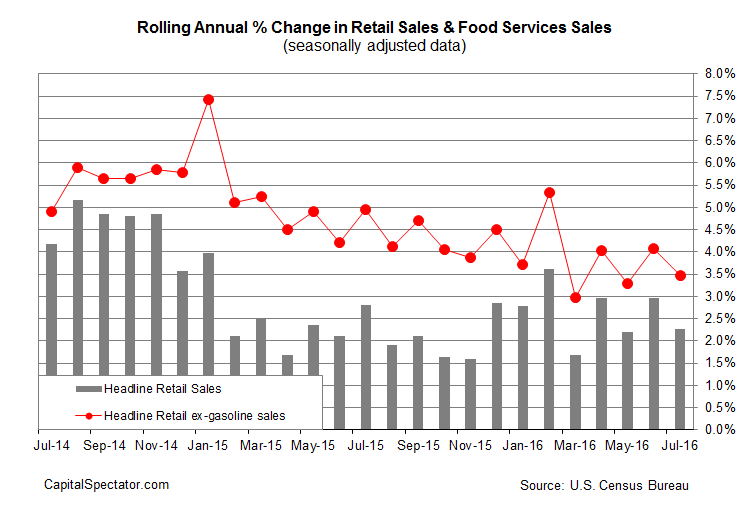US Retail Spending Remains Unchanged In July
Consumer spending in the US was flat in July, the Commerce Department reports.The surprisingly weak month may be payback for the strong gain in June, which surged 0.8% in today’s revised data. Meanwhile, the year-over-year trend in headline retail ticked lower. Putting it all together suggests that the appetite for consumption is still positive, but the growth rate is easing. Is that a concern? Maybe, although the recent revival in the pace of job creation implies that retail sales will continue to post steady if unspectacular growth.
Monthly data is noisy, of course, and so there’s a strong case for focusing on the annual comparison. By that standard it’s clear that sales growth is relatively modest compared with recent history. Note, however, that the 2.3% year-over-year increase, although historically low, is above the recent trough of 1.7% in March. It’s unclear if the mild revival has staying power, although the improvement in job growth in the last two months certainly lifts the odds in favor of optimism.

As usual, retail spending looks firmer after stripping out gasoline sales. Consumption ex-gas advanced 3.5% for the year through July. That’s not especially impressive either, although for the moment it’s not obvious that it’s a sign of trouble—largely due to the renewed strength in the labor market—and the low probability that a recession is near, based on data through June (and in subsequent updates via The US Business Cycle Risk Report).
Today’s retail sales data “is a bit disappointing, at least to start the quarter,” Kevin Cummins, an economist at RBS Securities, tells Bloomberg. “Labor income is the key. Confidence seems to be moving sideways.”
But as long as payrolls continue to grow at a healthy rate, which was clearly the case for June and July, it’s reasonable to expect that retail spending will hold steady and perhaps perk up in the months ahead.
Yesterday’s upbeat report on initial jobless claims for the first week of August certainly paints a bright profile for payrolls in the near term. New filings for unemployment benefits ticked down to 266,000 (seasonally adjusted), which is close to April’s 43-year low of 248,000. According to this leading indicator, the US economy is still poised to mint jobs at a solid rate.
“The [claims] data remain consistent with a still-strong trend in employment growth, which means the backdrop for consumer spending remains favorable,”notes Jim O’Sullivan, chief U.S. economist at High Frequency Economics via Reuters.
Disclosure: None.



